Travelogue:
Ireland-England-France
July 23-October 30, 2009
Roy Lisker
Prologue
This travelogue reports events and observations during a recent trip to Europe of about 100 days. Two months in this period were spent in Paris as a guest of the Institute Henri Poincaré, where I was nominally enrolled in a course in Combinatorics and Statistical Mechanics for the months of September and October. The 6 weeks of travels in Ireland, England and the south of France that preceded it were structured by invitations from friends, appointments and special projects.
From the economic standpoint it might have made more sense to organize two trips, say a month in Ireland and the UK, then a month back in the States, with a return to France in mid-September for the IHP program. I don’t know. The reason that people with a mathematics background have trouble with economics is that the concept of number has a different meaning in the respective sciences!
July 21, 2009: Boston
Before leaving Middletown to go to Boston I attempted to book a flight for August 1st On-Line, from Dublin to London, with Ryanair. The total fare was 21 euros, cheap indeed. Examining the printout of the reservation I discovered that it was for September 1st! Perhaps I’d clicked in the wrong box on the screen; or there may have been something wrong (malfunctionally or morally) with the Ryanair website. In either case I had to cancel the flight and start over.
Thereby I learned that that Ryanair charges a 35 euro cancellation fee; In addition the same flight on August 1st was not for the unbelievably low figure of 21 euros, but was now more like 126! I walked over to the local travel agency, Sanditz. to consult with my travel agent, Janna. She strongly advised me to do nothing until I arrived in Galway and spoke with a travel agent there.
Boston in July is verminous with tourists; I’d resigned myself to the ordeal of lugging two pieces of heavy luggage and a back-pack onto the MBTA trains going from South Station to Auditorium. From there it is an easy walk to the Boston Youth Hostel on Hemenway Street. Fortunately the rush hour was over. To my knowledge, there were no cosmic dramas at the Youth Hostel during my two nights there (unlike the time when the upper bunk of a double-decker bed collapsed onto the person sleeping underneath (no one was injured)). I did meet one interesting resident, a lanky, laconic young man from Vancouver who works as a baggage stevedore at the Vancouver airport. Although he has a few college degrees, he’s content with receiving the minimum wage for a job that involves heavy lifting. This is because it also gives him unlimited travel on Air Canada. In the past year alone he’s made a succession of short visits, lasting from one day to a week, to Boston, Hong Kong, Paris, San Francisco, New York and London.
This present stay in Boston was typical: one day to arrive and recover from jet lag; one day in Boston; return the next day (with reverse jet lag) in time to pick up his job. If he’s late even once he’s fired, so he always arranges back-ups with other workers. Since many young people work in airports for the same reasons, he has no trouble setting them up.
He warned me against using Ryanair (now pilloried even in the newspapers and the butt of stand-up comics). One always ends up paying much more than the tiny amount listed as the basic fare. The company slaps on fees , never less than $40, for the least deviation from the contract in small print : fees for cancellations; or luggage that isn’t tailored to exact specifications: or an overweight pound ; or neglecting to print out the boarding pass from the computer; or checking in at the airport rather than on-line. A trip advertised at a mere 10 euros, can end up costing 200 or more. Contrary to public perceptions, it’s better to go to a travel agent even if it costs a little bit more, rather than try to do a booking for oneself On-Line.
He gave me other valuable travel tips: because of respective superstitions, fares to Europe are low on the 13th of the month, fares to Asia are lower on the 4th. The lowest fares are on September 11th! One ought not get upset to find oneself is hauled out of line for inspection , luggage searches, cocaine sniffing dogs, eye scans, strip searches, the works. The security protocols in some airports specifies that every nth passenger be inspected, n a pre-arranged number.
Tuesday, July 22 was spent strolling about Boston. The talk of the town was the ludicrous farce of the arrest of Henry Louis Gates, Jr., caught trying to break into his own home after returning from featuring in a PBS special in China. The comedy combined all the trappings of outraged academic self-importance with the stock and trade of racial profiling. Apparently a conscientious neighbour noticed two black men, Gates and his chauffeur, late at night, breaking into a house in the elite district of Cambridge around Harvard University. Indignation, posturing, stereotyping, righteousness, slogans: the acme of a high vaudeville of town and gown.
That night I attended a short story reading at the Harvard Bookstore by Daniel Updike, the son of John Updike. Daniel Updike, who teaches at Roxbury College, considers himself a teacher first and a writer only second. He read us one story based on a teen-age infatuation in the 1950’s. Quite apart from his writing he appears to be an extremely likeable human, and it really didn’t seem to matter when he disparaged his efforts relative to his father’s. To tell the truth I’ve never cared much for the fiction of Updike senior.
On the afternoon of Wednesday, July 23rd, before going to Logan Airport I was treated to lunch at the Yenching Chinese restaurant in Harvard Square, by physicist Ed Taylor, friend of 3 decades and long-term Ferment subscriber. Ed is preparing a revised edition of the textbook he co-authored with John Archibald Wheeler on General Relativity. On the previous night he and his wife Carla had scoured their house for odd pounds and euros left over from their trips to Europe. Over lunch Ed pass me an envelope holding about $100 in odd change.
Having known each other for 30 years (starting with the turbulent period in 1980 when I was living in Cambridge and he was teaching at MIT) we found much to talk about. He passed along a standard physicist’s anti-mathematician joke: it appears that a mathematician from MIT was hit by a car while crossing the street. When the paramedics came to take him to the hospital, he is reported to have said: “I don’t understand. I did look one way!"
I was happy to be able to introduce Ed to the tiny Pamplona Café around the corner on Bow Street, its charm undiminished despite four decades of savage, ruthless destruction of all that was human, humane and harmonious, fun, friendly and free, (or warm, welcoming and wise!) in the Harvard Square of the 60’s. Granted that, in those same times, Harvard itself was patrician, prejudiced and pretentious, setting its’ obstinate face against the realities of the 20th century, the Square itself was a melting pot, a true marketplace of ideas, including every strand of the American cultural fabric in that youthful and dynamic age.
I left Ed at 3 to hurry back to the Boston hostel, pick up my luggage and take a taxi out to Logan Airport.
John and Emer Behan

In a Spanish restaurant, Galway
The author, on the left, wears a jazz shirt
My friends in Galway, the sculptor John Behan and his wife Emer welcomed me between July 23 and July 27th. There was 4-day transition period before going to London to stay for two weeks with a family in East Dulwich. The interim was spent as a tourist in Dublin.
July 24th, 5 AM: Shannon Airport
The Aer Lingus flight from Boston to Shannon takes 6 hours. By 6 AM I’d gone through customs and immigration and found myself walking through in the public thoroughfare of the airport looking for a bus to Galway. No sales agents were sitting in the Eirann Buslines booth. I went out onto the walkways and examined the bus schedules posted on the rain shelters. Powerful, menacing clouds loomed to the left, exhilarating for someone who’s rarely been near the ocean for over a decade. A handsome blackbird with strong beak was strolling on the wet lawn. I was certain that I’d seen it on my visit to Galway almost a year ago. I said hello but it ignored me. The age of courtesy is dead.
The bus schedules indicated that there would be an Eirann Buslines bus at 7:55, a wait of a good hour and a half. I tried to purchase a bus ticket from a machine in the lobby. The machine was very cranky, but I found someone familiar with the mechanism to help me. After 3 tries we were able to retrieve a 15 euro ticket.
Only after buying the ticket did it occur to me to ask someone in the Tourist Information booth at the far end of the hall when the next bus to Galway was leaving. There was in fact a Citylink bus to Galway leaving at 7:15, a saving of 40 minutes. Hurrying back out to the platform I saw that the Citylink bus preparing to leave. The driver could not exchange my Eirann Buslines fare for a ticket on his bus. So I went back into the airport, sat down and took a nap for half an hour. This is far from being the first time I’d been confused by competing bus lines giving essentially the same service but with different schedules; a similar incident happened in Glasgow in 2006.
The bus trip from Shannon to Galway takes two hours. Intermittent showers were separated by interludes of strong sunlight. However, by the time the bus pulled into Galway it was raining heavily. It had been arranged that I should call John and Emer upon arrival. My cell phone contract does not cover Europe, so I would have to use a payphone. If Ireland were anything like the US, all the payphones are rapidly disappearing!
Walking through the parking lot on the way to the train station I passed a taxi with a Nigerian driving sitting behind the wheel. John had suggested that I could a cab and the driver offered me the use of his cell phone. John answered; he told me to wait there and he would come and get me. The cab-driver wasn’t put out; he waved me on. There are many Nigerians in Galway today, as well as Croatians, Latvians and Poles. I’m waiting for Israel to join the Common Market and be forced to admit immigrants from the rest of the world. It’s time for the sharers of my Jewish DNA to return to a traditional source of our genius: thinking beyond the nation-state. As long as anti-Semitism leads to the expulsion of Jewish populations whose sole haven is Israel, this isn’t likely to happen any time soon.
I waited in front of the train station for John and his wife Emer to pick me up, which they did in about 15 minutes. John, who has become one of Ireland’s best known sculptors, has had two hip operations in the last year and can’t drive, so Emer was at the wheel. She drove us to their house on the lower stretch of the Galway Canal.

John and Emer’s house on the Lower Canal, Galway
A wooden plaque on the outer wall holds the mysterious name, Llanac
: L for “lower" with “canal" written backwards. Emer said that the sign was there when they moved in a few years ago, and they just left it!

The Galway Canal encourages one in thoughts of grim foreboding.

Eutrophy is ravaging parts of the canal
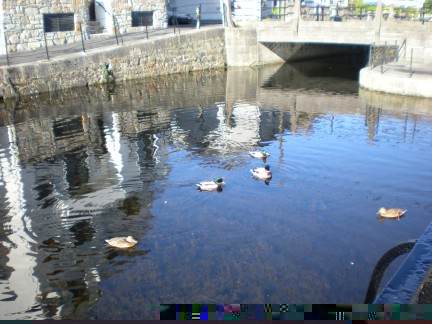
The many species of ducks provide much needed cheer!
Over breakfast my hosts told me about the catastrophe that has overtaken the Emerald Isle in the wake of the world economic crisis. Nietzsche (or is it Hegel?) was right: history is catacyclic, one catastrophe after another. Last year the Irish government promised that to guarantee 100% protective coverage of all deposits in Irish banks. Soon afterwards millions of euros came pouring into Ireland’s banks from corporations across the European Union. Superficially one might have interpreted this as a self-fulfilling prophecy. With every other nation investing in Ireland’s banks, how could they fail?
Yet the banks, with government approval, proceeded to squander, literally give away, billions of euros to so-called real estate speculators and developers, some visionary, others crank, mostly gangsters. They sank the money in pointless construction schemes around the world notably in Eastern Europe and Turkey. According to John, one can see tourist resorts, giant building complexes all along the Danube, abandoned in mid-construction and permanently empty.
Ireland is bankrupt, its reputation for fiscal responsibility shattered. The subprime mortgage crisis was also re-enacted here: people continue to be tossed out of their homes, and the more or less permanent state of impoverishment of the nation has re-asserted itself. However things will probably never be as bad as they were in the 70’s, when I visited Ireland for the first time: the prosperity brought in by the IT revolution remains a mitigating factor.
That evening John took me to a downtown hotel to attend a poetry reading given by a prominent Irish poet, Micheal O’Siadhail (“Michael O’Shay"). He’s well known in the US; by his own account he’s seen more of my country than I have, through having given poetry readings in every major city and many college towns in dozens of states. He was acquainted with Middletown through his poetry readings in New Haven and Hartford.
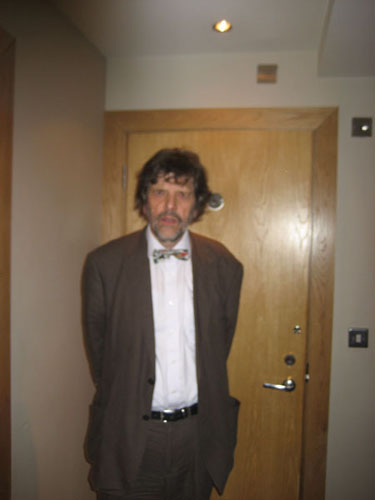
Micheal O’Siadhail
O’Siadhail’s appearance is striking, very much the poète engagé, not quite the poète maudite, but close. He’d knotted an utterly absurd bow tie around his collar, while his scraggly black beard was cultivated to good effect. His manner was nervous yet friendly, with a soft almost rasping voice. Micheal read from a lecturn in a small room closed to the street by thick curtains; an audience of about 30 filled the seats.
Micheal is a seasoned reader of his own work; the comments between each piece were as interesting as the poetry itself. His reading began with items from “Love Life", a series of love poems, many to his former wife. He commented that poets who write lots of love poetry when young write elegies when they grow old.
The next group of poems, reflecting his political concerns, came from his book “The Gossamer Wall". This book has stirred the boiling pots of controversy. Micheal said that he’d never encountered the controversy directly, but people keep telling him about it: the book consists of a series of invented portraits of people who’d worked at various jobs in the concentration camps during the Holocaust. What appears to have upset his readers is that he’s giving recognition to people “caught in the middle", treating them as subjects worthy of being written about, rather than the usual cast of victims and victimizers. He later remarked to me that the one question he was asked everywhere in his recitals in the United States was "What is your connection to the Holocaust?" ( Translation: Are you Jewish?) We both agreed that there is something very horrible about having to “justify" a connection to the Holocaust.
Micheal is also interested in modern mathematics. One of his poems is entitled “The Butterfly Effect"; another uses imagery from Knot Theory. The latter poem is a take-off on expressions normally employed to describe the decision to marry: “tying the knot", “getting spliced", “getting hitched", and “taking the plunge" (down the infinite quantum potential well?) !
After the reading, Micheal, John and I went downstairs to join 3 others at a table in the bar of the hotel. We were about the begin one of those ritual Irish pub literary binges (the tradition dates back to the mead halls of Beowulf), in which wine, beer, ale, learned conversation, gossip and tall stories flow freely and abundantly. The celebration goes on through the night until everyone is totally pissed. Mercifully (this doesn’t mean I didn’t enjoy myself!) this one ended around midnight. Age has its compensations
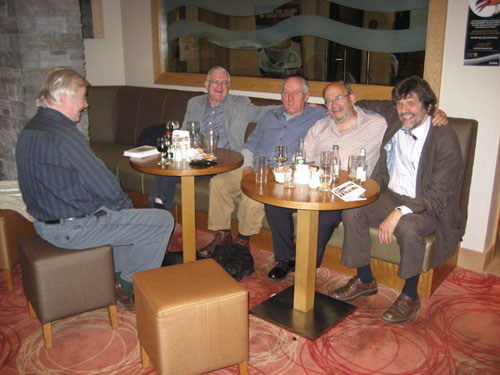
Left to right: John Behan, Brian Arkins, Brien Bourke, Self, Micheal O’Siadhail
Personally I don’t find anything funny about a delightful nation ruined for centuries by alcoholism. Once in a long while, and I mean that very seriously, a long while, the time-honored Symposium, Estaffod or troubadour tradition of spirits, language and song (did I get the expression right?) can be good for heart and mind, even miraculous.
And everyone at this particular bardic reunion was capable of making a strong contribution. Micheal, John and myself joined a group including Brien Bourke, painter (John has some of his work hanging in his living-room); his wife Jay, also a painter; and Brian Arkins, former chairman of the classics department at the University of Galway, and honorary president of the Classical Association of Ireland. He talked little. It was Brien who compulsively related one story after another. As literary types Micheal and myself kept up our end well enough. Later John and Emer told me that Brian Arkins is a ‘genius’, a master of many languages, and a world renowned authority on Latin poetry.
Much in evidence in Brien’s stories was the uniquely Irish sense of humor. There are some cultures that have no trouble acknowledging the role of death in our daily lives, nor are they inhibited from working it into their stories, dreams and conversations. English civilization, which includes our own, has developed a craving for dominance, an obsession with prevailing, a “Raj" mentality that makes us unable to face the absurdity of our ultimate and inevitable demise.
The Irish are not like that: they can still laugh about death and dying, and stupidity, failure, insanity and disease, the universal afflictions. The imperialist mind-set of all too many Anglo-Americans does not find these things amusing.
A large percentage of Brien’s fables were about depraved, ignorant or malicious priests and nuns. There was no love lost for the church in this gathering. Their strongest voices of condemnation were directed against the Christian Brothers, a teaching order founded in Ireland in 1802, that has controlled Irish education for two centuries. The pedophile scandals that rocked the United States were vastly exceeded by the revelations in Ireland. Brien and John spoke openly about groups of Christian Brother teachers who would close a window on a child’s naked body straddled over the ledge, primped for systematic gang-banged.
Both Brian Arkins and Micheal O’Siadhall were educated at Clongowes, the Jesuit college that James Joyce writes about in Portrait of the Artist. They traded memories about teachers they’d studied under.
Saturday, July 25th
The horse races on Omey Island, Connemara.
On July 25th John and Emer drove out with me along the Connemara coast to the sand island of Omey, near the town of Claddaghduff. Horse races are held here once a year. For half the day the island is covered by the ocean. Everything: tracks, posts, fences, book-makers stands, portable toilets, the food trucks and parking lots, must be set up, then dismantled between 6 AM, when the tide goes out, and its’ return at 6 PM. A carnival area with swings and games is set aside for the children. The food trucks serve wine, beer, fish and chips, and something called a “Super-Mac", a copy-burger of the McDonald’s Big Macs. The races are free, but as there are no bleachers the spectators have to stand.
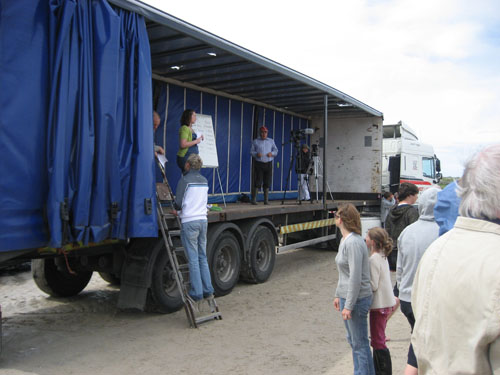
The Announcers Platform
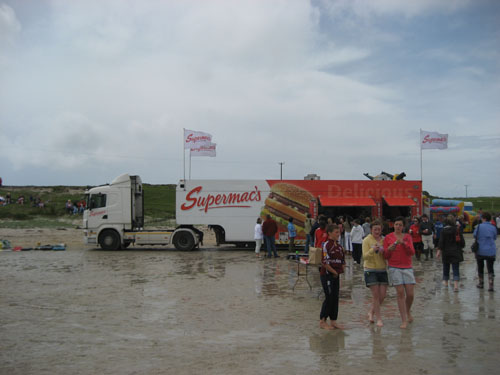
Food Concessions
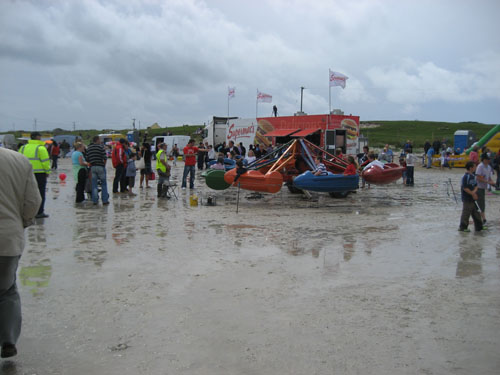
Playground
The parking lot that takes up most of the island is a messy area, difficult to walk through, water-soaked from the fluctuations of the rains and the remnants of the retreating ocean.
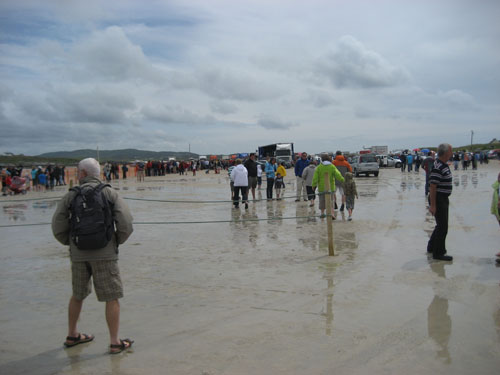
Parking Lot
The horses are very handsome, compact, strong. Connemara horses have been famous the world over for at least 800 years. The black-brown horses that participate in these races are smaller than thoroughbreds by about a hand, yet larger than the traditional Connemara pony. Another unusual feature is the age of the jockeys. They are all local boys and girls, some as young as 11, none older than 15. Training to become a jockey, like training to become a ballet dancer, begins in childhood.
The shoreline road is surrounded by hills and mountains to the east and north. Prominent among them is a group called the 12 Pins. These touched the clouds, which hanged low over the land, shedding showers between brief intervals of hot sunlight.
The Connemara Shoreline
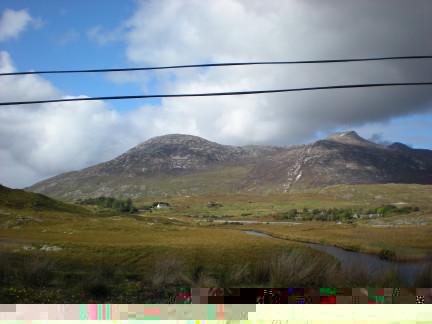

The 12 Pins
The Behans' car passed through Claddaghduff around 1 and crossed over a shallow land bridge onto Omey. Emer parked the car close to the fences and ropes demarcating the track ropes. It allowed us to watch the horses streaming by for awhile without having to join the crowds.
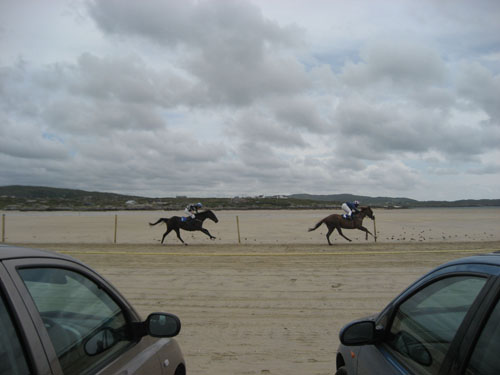
It was quite surprising to see these adolescent jockeys, already professionals, drive their horses for two or three laps around the track. One of them, a young girl of perhaps 12, wasn’t doing very well. She was trailing the others and compulsively whipping her horse. While knowing nothing about the sport I would suggest that the use of whips should be abandoned, not only because they may hurt or injure the horse. For me they’re the equivalent of giving steroids to a football player.
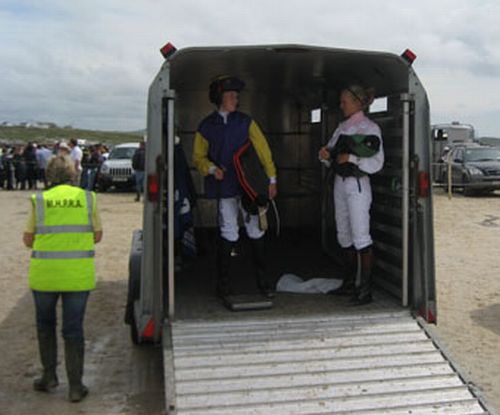
The jockeys
After eating a picnic lunch we got out of the car and walked to the main area. The bookie stands were set up about 50 metres from the tracks. John placed a bet on the favorite, a horse named Pretty Woman. He won 50 euros on his first bet, but lost most of it on subsequent bets.
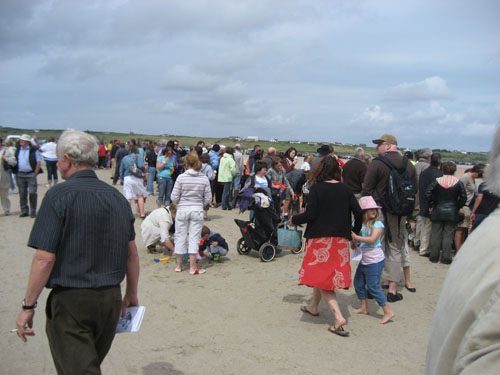
Spectators numbering several hundred, perhaps a thousand, were pressed up against the fences. Close by stood a long flat-bed truck opened on one side. In the center of the platform stood a woman writing the odd names of the horses (Poker Face, Winchester, Little Man, etc…) on a piece of posterboard mounted on an easel. Standing beside her, a man belted out the names, capturing the excitement of the race as horses took the lead or fell behind.
John was drinking white wine and beer. He encouraged me to do the same; however I’d lost interest in drinking after the notorious bash on the night of my arrival. The addiction to alcohol one finds in Ireland must have a genetic basis. John is far from being an alcoholic by local standards, though he might be judged so in the US.
We were joined by a friend, Mary Murphy. She is the ex-wife of Tom Murphy, the playwright; one of his plays, “The Gigli Concert", was featured in the Galway Arts Festival. She and Tom are divorced. She has serious problems with emphysema, but smokes two packs of cigarettes a day. In a country where a pack of cigarettes costs 12 dollars, this is an investment of real money; she comes from a wealthy family. A sad, charming woman. I concluded that she reminded me most of Masha, from Chekhov’s “Seagull".
Many factors contributed to the success of the outing: the informality, the closeness to the sea, the youthful jockeys, the beauty, health and strength of the horses, obvious even to someone who knows nothing about horses and horse-races.
As early as 5 we could see the tide coming back. The races would end at 5:30 and everything had to be dismantled by 6:30. The car didn’t start at first, which led to speculations about wading through or drowning in the approaching flood; but we got it to work and were on our way.
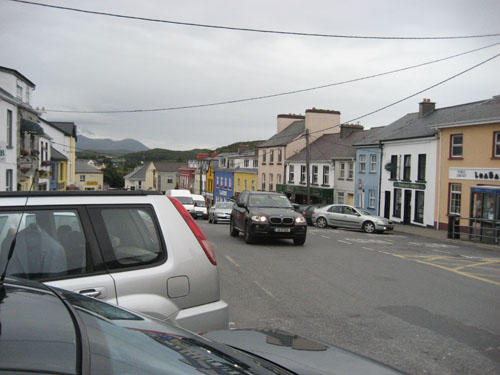
Clifden, Connemara
Our next stop was Clifden. The town comes alive for half the year from the tourist trade, then all but closes down in the winter. On the way to Mitchell’s restaurant for dinner I picked up a custom-knitted white Merino-wool sweater for 29 euros.
The owner and waiters at Mitchell’s are Polish. Eastern European immigrants have become an important feature in Ireland’s economy. When the town closes up in winter, Mitchell goes to the Florida Keys, where he’s built a house. Food, atmosphere and service were excellent; Mitchell's comes highly recommended. Tell that to Rick Steves (who seems to think that travel writing consists of little beyond recommendations of restaurants and hotels) when you see him next.
Mitchell’s Restaurant
The Galway Arts Festival
The late medieval brickwork, roadways and canals of the city are romantic and beautiful. It is a delight to follow the meandering streams branching off the estuary of the Corrib River.


The Corrib river and estuary.
My visit with John and Emer coincided with the second week of the Galway Arts Festival. Until recently Galway was a sleepy town of 40,000. Now there are over 100,000 residents of the area, which continues to grow. The largely international character of the Galway Arts Festival is a testimony to its increasing importance as an urban center.
Shop Street, Galway
The old city in particular has become something of a tourist circus; I frequently had to rationalise my visits to its boisterous carnival atmosphere. The sophistry I devised to deal with this moral dilemma continues to delight me: I wasn’t really enjoying the crowds, nor the artifacts, nor the entertainment, plastic, ersatz or genuine: instead I was engaged in the serious study of Galway’s local industries, including fishing and peat farming, of which tourism is one!
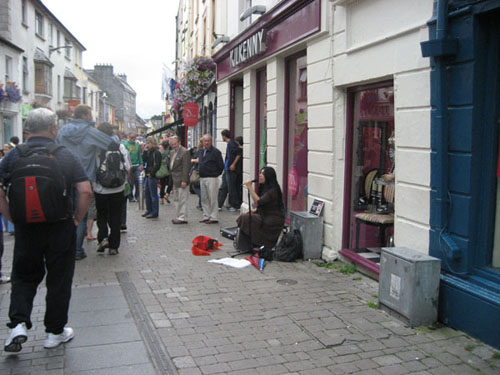
Buskers, Galway, Old City
The Arts Festival raised the cultural level considerably and one did not have to feel ashamed of being a participant in it. It went from Monday, July 13 to Sunday, July 26th. Its productions were strong in all the arts, theatre, painting and sculpture, photography, music, dance. Theatrical productions included two of Shakespeare’s plays, (The Merchant of Venice and A Midsummer’s Night’s Dream), a Beckett play (Krapp’s Last Tape), plays by contemporary Irish playwrights, Tom Murphy, Shona McCarthy, David Harrower, and a mixed-media retrospective of the life and work of John Millington Synge.
Music dominated the festival: performance groups came from everywhere and included the Kronos Quartet, Spanish Harlem Orchestra, the Romanian composer Alexander Balanescu, and ensembles and bands from Ireland, England, Denmark and Nigeria.
Altogether there were 64 arts events: 15 performances of plays and dances, 15 exhibitions, 28 musical ensembles, several poetry readings and events for children. What I’m giving is the official schedule. There must also have been an unofficial, or fringe festival that I wasn’t made aware of. As it was, there was plenty to do and see from the official calendar.
With the generous backing of John and Emer Behan I took in 4 events: “Blackbird", the play by David Harrower; the Synge Centenary commemorative; the poetry reading of Micheal O’Siadhail, already described; and the art exhibitions in the Art Gallery adjacent to the headquarters of the Arts Festival, on Merchant Street near the docks. John and Emer invited me to go with them to the Shakespeare productions, but I am something of an enthusiast for the Bard, and have stocked up on too many of his plays over the last year to want to sit through another one.
The “Blackbird" poster

Convent of the silent “Sisters of St. Clare"
“Blackbird" by David Harrower is ostensibly about child abuse, a very big topic in Ireland today: the crimes of the sicker minds among the Catholic clergy continue to nourish the media’s insatiable craving for scandal. Paradoxically, the play was produced in the “Nun’s Island" theatre, down the street leading to the convent of the Sisters of Saint Clare. Their vow of silence, I gather, allows them only 20 minutes of speech per day.
The culprit in Blackbird is not a priest. There are only two characters in the play: a middle-aged man and a woman 19 years his junior. 15 years earlier he, at the age of 31, entered into a physical relationship with the 12-year old girl. Both of their lives were ruined: he spent 6 years in jail, while she became a pariah and outcast in her own community.
15 years later she seeks him out, ostensibly to cast judgement on him. As the play progresses it appears that they are really interested in bringing together a relationship that, in a more forgiving society, could have resulted in a productive relationship and even marriage somewhere along the line.
One enters the theatre thinking that the play is about a predatory male taking advantage of a minor, yet one leaves it with the impression that it is also about a destructive teen-ager who, because of her psychological needs, sets out to ruin the life of an older man. The synthesis approximates basic human reality, which can rarely be decomposed into classes of victimizers and victims. “Blackbird" in other words was complex and intense, with excellent performances by Stuart Graham and Judith Roddy.
 Galway Arts Festival Gallery
Galway Arts Festival Gallery
The Festival Arts Gallery was housed in a long building on the docks that must once have served as a warehouse. The space was well illuminated, both by artificial light and sunlight coming in from the street. The exhibition on the ground floor, entitled “Notes of a Silence", held paintings by Ger Sweeney. John admitted that Sweeney is a good artist, which means he must be very good indeed. An artist will be generous with his praise of another artist only if:
(1) The artist is so sub-standard that the commenter is employing one of the traditional tropes of condescension, or:
(2) The artist is so good that the truth cannot be denied!
In this case it is clearly the latter which was operative
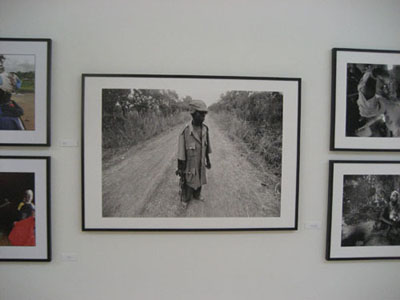
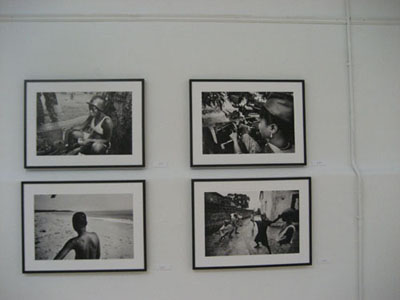
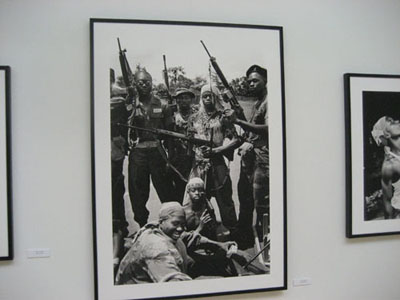
The abstract paintings by Ger Sweeney did not prepare one for the exhibition on the upper floor: framed and mounted photographs by photo-journalists from Denmark, Bosnia, Italy and Greece, of child soldiers in Palestine, Nepal, Liberia, Sierra Leone, Uganda and the Congo. The walls of the upper floor surrounded the staircase leading from the ground floor like a long box enclosing a cough-drop lozenge. There was plenty of space to move around, talk with others and take pictures, which were permitted.
One gazes at these photographs with a mixture of horror, outrage and compassion. Yet also admiration: admiration for the quality of the work itself, yet also for the humanity and vitality of the children themselves, who have found ways to survive, physically and psychologically under such harrowing conditions.
The mixed media Synge Centenary retrospective prepared by the Druid Theatre Company was performed on the evening of July 26th in the historically treasured old St Nicholas church. The church was originally Catholic but was (converted? re-converted?) into the Anglican church it is today under the British occupation. I asked John if the Church of Ireland (the Irish branch of the Anglican church) has much of a following in Eire; he said that only about 3% of the population is Protestant. Obviously this figure changes abruptly when one crosses the border into Northern Ireland. The Catholic/Protestant schism is, even today, so fundamental in shaping the history of modern Europe that, although one believes in neither religion, and (like myself), doesn’t even bother to consider whether or not one is an atheist (Are there creatures on Sirius? Does the question matter?) it is important to study it to understand today’s world of today.
The St. Nicholas church is a masterpiece of stonework, supported by strong pillars holding up a great vault. If there are stalls or pews, they’d been moved to the sides to make space for the chairs and the stage, which faced the altar and the stained glass windows at the back. Two film screens were set up, one in back of the stage, the other to the side. The actors, scripts in hand, sat on chairs aligned in a row perpendicular to the audience. John Millington Synge died in 1909, at the age of 37. The Synge Centenary, combining letters, journals and excerpts from biographies and memoirs, was performed in the commemorative style that has become current. Interspersed with these readings were performances of scenes from all six of Synge’s published plays. The powerful final act of “Riders to the Sea" (a scene that must certainly have inspired Garcia-Lorca when he wrote Blood Wedding) was shown in an early film version.
Synge apparently knew from an early age that he was not destined to live long. Therefore he concentrated his work into 15 years, realizing he would not have the leisure to re-write or expand it later. Readings and performances were first-rate, re-affirming the superiority of the Irish theatre tradition. The evening was marred by a major technical failing: the reverberations in the church were so overpowering that I wasn’t able to understand more than 20% of anything that was being said! The more sonorous and rich the voice, the more complete was the masking by the echoes and reverberations, with the sad result that those actors who’d worked to develop a rich, musical voice were the ones that were least understood! This was not because my ears were unadapted to the West Irish dialect: John had the same reaction.
Back at their house over a light dinner John, Emer and I drenched ourselves in the darker side of Irish life, reading the sordid accounts of crimes, fraud, political scandals, clerical corruption from the pages of the weekend editions of The Irish Times and the Irish Independent. One finds such things everywhere, although there is a quality of anarchism that pervades the way they are done (and reported) in Ireland. This is a country where journalists are required to be decent writers as well; the recounting of even the most hum-drum news-item is accompanied with irony, salty wit and dry humor.
Dublin, July 28-31, 2009
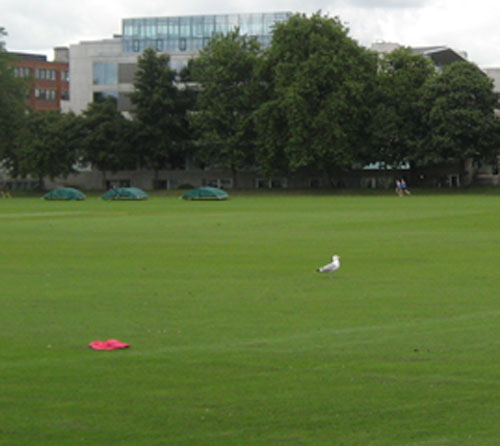
This proud and stately gull was seen walking across the cricket field on the Trinity College campus. Every inch the don, it was no doubt on his way to dinner at the high table (hopefully, not where he is eaten!) Judging from my own experience in 1971, after an invocation recited in Latin by a student garbed in academic robes, he’ll be served creamed peas on toast.
St. Patrick's Cathedral. Jonathan Swift was its’ dean from 1713 to 1745. In the last years of his life, battling encroaching insanity, Swift willed ₤ 11,000 towards the founding of Dublin’s mental hospital. How “Enlightenment"! Modern advanced thinking has replaced these reliques by chemicals, putting the mentally ill back out on the streets again.
The Dublin Tour bus carrying me around the city includes the old asylum in its list of attractions. Research done recently indicates that Jonathan Swift suffered from a rare ear infection.
The windows of this pub, located near Merrion Square and St Stephen's Green, are filled with knick-knacks, curios, bottles and dust.
The Project Centre in Temple Bar. Painters and sculptors, including John Behan, started up the Project Gallery in 1970. The key incidents in my novel "Harvest of Chains", Harvest of Chains are connected with this gallery. In the 70’s it was an innovative gallery promoting talented artists. Today it is housed in a smart blue brick, glass and plastic building on Essex Street in the Temple Bar, the "official arts district" for Dublin, and funded by the government.
I spoke with Francis, a young man, in his 20’s, at the reception desk. After expressing interest in the stories I told him about Dublin in the 70's, he gave me his opinion about the Temple Bar. The old story: this formerly ‘disreputable’ part of town was ‘cleaned up’. All the ‘worthless sorts’ were chased away and the ‘serious, respectable and hard-working’ artists moved in. There was a honeymoon for a few years until the new Bohemia was ‘discovered’ by developers. Rents soared, the artists were evicted. Now the traditional pubs are replaced by Disneyland parodies of ‘genuine Irish pubs’, while the life and culture of the district are frozen like insects in amber. I was unable to find the time or money to verify Francis’ dismal saga in detail, but I’m sure he’s right.
Phoenix Park, the largest urban park in the world. These pictures were taken through the window of the Dublin tour bus, which I took twice.
15 Acres. The area in Phoenix Park known as 15 acres is actually 200 acres in size. In the 18th century it was set aside for the hunting parties of the aristocracy and rich gentry, and stocked with deer and pheasants. Eventually poachers cleaned out the livestock. There are 500 deer still remaining in this part of the Phoenix Park that are occasionally seen by pedestrians.
Junction of Nassau and Grafton Streets. Shops, stores, crowds, the hubbub of buying and selling. All modern nations strive to imitate the United States, the nation that builds shopping malls and drops bombs. There were some very good buskers on Grafton Street, including the Slovak Festival Orchestra of Vladimir Jablonsky, and a charming music student in her 20's doing a deft rendition of Kreisler's Schoen Rosmarin".
Kilmainham Prison. During the famine of 1845, people actually tried to get into this prison so that they could have at least one meal a day. In 1916 40 people were executed by the British army for their part in the Post Office insurrection. England promised Ireland its independence after WWI (in which 50,000 Irish soldiers were killed) but reneged after the war, as it did with all its colonies. This led to the war of independence and the civil war. Ireland became a republic in 1923.
A hallway in the Hamilton Building, Trinity College. It’s named for William Rowan Hamilton, who is, barring new evidence or contenders to the contrary, Ireland's greatest mathematician. The building houses Mathematics, Physics, Engineering, and a theater. I left 3 copies of my "50 Problems Anthology" on the magazine rack of the Mathematics Department lounge.
Main building of the Dublin Institute for Advanced Study. The DIAS was established by Eamon deValera, a former mathematics teacher and Ireland’s first Taosaich, (prime minister) as a refuge for Erwin Schroedinger during World War 2. Its’ two divisions, Theoretical Physics and Celtic Language studies, reflect deValera's two intellectual passions.
Christchurch Cathedral. The foundations were laid by the Normans in the 12th century. There are so many churches
in Dublin that one can orient one's way around the city through sightings of their spires.
Dublin, 1970: A reminiscence
After giving an interview for Radio Eirann touching on my background as a draft resister, the word went around the city that this American "draft dodger" who was wanted by the FBI, was living in Dublin though he was supposed to be in jail back home. My friends, of course understood that this was not the case, that I was a true resister, not a draft dodger, and that I would eventually be going back. However, soon afterwards I was told that there was another American in exile living in Dublin, who was wanted by the Feds, that I might want to meet. I caught up with him at the counter of the Bailey Pub off Grafton Street. His name (not real) was Bob Boxer, and he was a CIA agent who’d been kicked out of Holland after his cover was blown, trying to make another life for himself in Ireland.
Boxer was like his name, belligerent. A bully’s face retaining ape-like features turned sheepish when drunk: his eyes rolled as if he were lost in space and his speech became blurred. There is no doubt that he might be dangerous if crossed. He also apparently had the bad habit of boasting about his exploits with the CIA when he was drunk. This sent everyone in the seats adjacent to him running for cover.
He was heavy-set, slightly jowled, very pale, with a crew cut and other indications of a Marine background. He always dressed in a thick black coat and shuffled rather than walked when he crossed the room. After I’d met him a few times he came to me with a proposition. He’d learned that I’d done some journalism and was a talented writer. He proposed that we write up the story of his years with the CIA as an exposé that we could sell to the News of the World for, say. £10,000. I would get a 20% commission. This sounded all right to me and I began my interviews with Bob in his apartment. He introduced me to his Dutch wife. She plays an important role in the story which we will come to.
After being captured from captivity in China during the Korean War, Boxer returned to Yale. Yale is a natural recruiting ground for CIA agents. What impressed the Agency about his background was that he’d spent a few years in a Chinese prison camp without giving a forced confession or recanting. He was advised to continue his education, go onto medical school and specialize in anaesthesiology. This is a common cover for agents. One can pick and choose when and where to work, and one doesn’t have to go back to school very often to learn new procedures.
Boxer’s father was a naval officer in Canada. This was also a plus for his background. His job was to go to countries such as Mexico and Brazil, insinuate himself into the confidence of the military, when possible marry the daughters of highly placed officers, then use his position to gain access to important inside information that would enable the CIA to stage acoup-d’état and overthrow the government. He claimed to me that he’d been married in both of these countries. When the job was over, he simply disappeared and the CIA arranged the paperwork so that these marriages had never existed.
After that he became a hotel manager on several Caribbean islands. Since the CIA provided the funding, the hotels didn’t have to make a profit, and he spent most of his time arranging parties for highly placed politicians, military and businessmen. He was also involved in some way with monitoring spy satellite launching in the Caribbean, which are far more numerous than what is reported in the newspapers.
He said that there were no patriots in the CIA; they were all out for money and nothing else. He admitted that his years as a hotel manager had made him a confirmed alcoholic, therefore unsuitable for really difficult or dangerous missions. He was therefore posted to Europe, where he had the relatively simple job of visiting NATO sites and seeing how easy it would be to breach security.
It should be understood that I`m recording what he told me, with no independent source of verification. However the intention was to sell the story to a tabloid paper that would require more substantial verification. He ended up in Holland, which claimed, officially, that it had no NATO bases. He told me that it was child’s play to get onto the NATO airfields, where one could easily plant a grenade or bomb into the vents of the jet planes.
Once again he married the daughter of a highly decorated military officer; this time, so he claimed, for love. When the Dutch government discovered his real employer, her father did his own investigating and uncovered his past. He may have thought that the CIA was planning an operation in Holland similar to the ones he`d carried out in Mexico and Brazil! Bob Boxer was rounded up within a day or so and expelled from Holland, his cover blown. His wife joined him shortly afterwards.
Now he was enrolled at Trinity in a refresher course in anaesthesiology, hoping perhaps to keep a low profile and settle into a comfortable, if second-level, medical career. Several factors militated against this. There was his drinking of course, and the fact that he shot his mouth off in the center city Dublin pubs whenever he got drunk. The Garda were also keeping a close watch on him; every time I went to visit him I saw that the number of police vans had markedly increased. It is more than likely that the CIA were taking more than a passing interest in him as well.
When I’d written and typed up essentially what is related here, he took my manuscript and hopped off to England to contact the News of the World. I’ve not seen him since, and I doubt that his wife has. After a few days he telephoned to say that the News of the World were only willing to pay something like £1000. In addition, it wanted solid documentation to substantiate his stories.
A week later he telephoned again to say that he was working as a waiter in a pub somewhere in England. Then no more communication. Nothing. He may have just flown the coop, or the CIA had gotten to him. Or something else.
His wife was left without a penny. The next time I visited her we sat around discussing what to do. Over the next few days I walked with her over to the various pawnshops around Dublin, so she could get rid of everything that might bring in a few shillings or pounds. She needed to raise enough money to get back to Holland, where she might possibly be able to effect some reconciliation with her family.
A lone draft-card burner stranded in Dublin posed no threat to the government, and I never noticed a Garda on my tail for the few months that I remained in Dublin before going back to France.

















